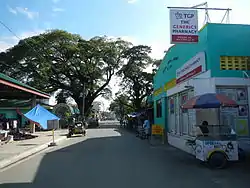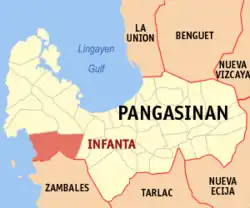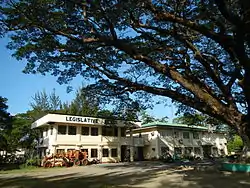Infanta | |
|---|---|
| Municipality of Infanta | |
 Downtown area | |
 Flag  Seal | |
 Map of Pangasinan with Infanta highlighted | |
OpenStreetMap | |
.svg.png.webp) Infanta Location within the Philippines | |
| Coordinates: 15°49′15″N 119°54′30″E / 15.82083°N 119.90833°E | |
| Country | Philippines |
| Region | Ilocos Region |
| Province | Pangasinan |
| District | 1st district |
| Founded | October 4, 1876 |
| Barangays | 13 (see Barangays) |
| Government | |
| • Type | Sangguniang Bayan |
| • Mayor | Marvin M. Martinez |
| • Vice Mayor | Virgilio F. Vallarta |
| • Representative | Arnold D. Celeste |
| • Municipal Council | Members |
| • Electorate | 17,534 voters (2022) |
| Area | |
| • Total | 254.29 km2 (98.18 sq mi) |
| Highest elevation | 163 m (535 ft) |
| Lowest elevation | 0 m (0 ft) |
| Population (2020 census)[3] | |
| • Total | 26,242 |
| • Density | 100/km2 (270/sq mi) |
| • Households | 6,460 |
| Economy | |
| • Income class | 3rd municipal income class |
| • Poverty incidence | 12.78 |
| • Revenue | ₱ 150.8 million (2020) |
| • Assets | ₱ 399.8 million (2020) |
| • Expenditure | ₱ 136.2 million (2020) |
| • Liabilities | ₱ 123.6 million (2020) |
| Service provider | |
| • Electricity | Pangasinan 1 Electric Cooperative (PANELCO 1) |
| Time zone | UTC+8 (PST) |
| ZIP code | 2412 |
| PSGC | |
| IDD : area code | +63 (0)75 |
| Native languages | Pangasinan Sambal Ilocano Tagalog |
| Website | infantapangasinan |
Infanta, officially the Municipality of Infanta (Pangasinan: Baley na Infanta; Ilocano: Ili ti Infanta; Sambal: Babali nin Infanta; Filipino: Bayan ng Infanta), is a 3rd class municipality in the province of Pangasinan, Philippines. According to the 2020 census, it has a population of 26,242 people.[3]
Infanta is 117 kilometers (73 mi) from Lingayen and 323 kilometers (201 mi) from Manila.
Etymology
Infanta got its name from a word that means "young," as it was an "offspring" created out of Santa Cruz, Zambales.[5]
History
On October 4, 1876, Infanta, originally a barrio, was created out of Santa Cruz, Zambales to become an independent municipality by virtue of a Superior Decree by the Spanish colonial government.[5]
On November 20, 1903, Infanta was separated from Zambales and was annexed to Pangasinan by virtue of Act No. 1004.[6]
Geography
Barangays
Infanta is politically subdivided into 13 barangays. Each barangay consists of puroks and some have sitios.
- Bamban
- Batang
- Bayambang
- Cato
- Doliman
- Patima
- Maya
- Nangalisan
- Nayom
- Pita
- Poblacion
- Potol
- Babuyan
Climate
| Climate data for Infanta, Pangasinan | |||||||||||||
|---|---|---|---|---|---|---|---|---|---|---|---|---|---|
| Month | Jan | Feb | Mar | Apr | May | Jun | Jul | Aug | Sep | Oct | Nov | Dec | Year |
| Mean daily maximum °C (°F) | 31 (88) |
31 (88) |
31 (88) |
33 (91) |
32 (90) |
32 (90) |
30 (86) |
30 (86) |
30 (86) |
31 (88) |
31 (88) |
31 (88) |
31 (88) |
| Mean daily minimum °C (°F) | 21 (70) |
21 (70) |
22 (72) |
24 (75) |
24 (75) |
24 (75) |
23 (73) |
23 (73) |
23 (73) |
23 (73) |
23 (73) |
22 (72) |
23 (73) |
| Average precipitation mm (inches) | 5.1 (0.20) |
11.6 (0.46) |
21.1 (0.83) |
27.7 (1.09) |
232.9 (9.17) |
350.8 (13.81) |
679.8 (26.76) |
733.1 (28.86) |
505 (19.9) |
176.6 (6.95) |
67.2 (2.65) |
17.7 (0.70) |
2,828.6 (111.38) |
| Average rainy days | 3 | 3 | 3 | 4 | 14 | 18 | 23 | 25 | 22 | 15 | 8 | 4 | 142 |
| Source: World Weather Online[7] | |||||||||||||
Demographics
| Year | Pop. | ±% p.a. |
|---|---|---|
| 1903 | 3,546 | — |
| 1918 | 5,613 | +3.11% |
| 1939 | 5,453 | −0.14% |
| 1948 | 5,379 | −0.15% |
| 1960 | 7,582 | +2.90% |
| 1970 | 10,469 | +3.28% |
| 1975 | 11,336 | +1.61% |
| 1980 | 12,323 | +1.68% |
| 1990 | 16,149 | +2.74% |
| 1995 | 18,839 | +2.93% |
| 2000 | 20,632 | +1.97% |
| 2007 | 23,731 | +1.95% |
| 2010 | 23,455 | −0.42% |
| 2015 | 24,584 | +0.90% |
| 2020 | 26,242 | +1.29% |
| Source: Philippine Statistics Authority[8][9][10][11] | ||
The largest number of people of Infanta are Sambals, generally speak Pangasinan, Sambal, and Ilocano.
Economy

Government
Local government
Infanta, belonging to the first congressional district of the province of Pangasinan, is governed by a mayor designated as its local chief executive and by a municipal council as its legislative body in accordance with the Local Government Code. The mayor, vice mayor, and the councilors are elected directly by the people through an election which is being held every three years.
Elected officials
| Position | Name |
|---|---|
| Congressman | Arnold F. Celeste |
| Mayor | Marvin M. Martinez |
| Vice-Mayor | Virgilio F. Vallarta |
| Councilors | Jerome N. Melanio |
| Luz M. Daragay | |
| Luis M. Madarang | |
| Alex M. Maniago Jr. | |
| Erdolfa A. Soriano | |
| Yolanda K. Legaspi | |
| Efren C. Millora | |
| Remedios M. Navajas | |
References
- ↑ Municipality of Infanta | (DILG)
- ↑ "2015 Census of Population, Report No. 3 – Population, Land Area, and Population Density" (PDF). Philippine Statistics Authority. Quezon City, Philippines. August 2016. ISSN 0117-1453. Archived (PDF) from the original on May 25, 2021. Retrieved July 16, 2021.
- 1 2 Census of Population (2020). "Region I (Ilocos Region)". Total Population by Province, City, Municipality and Barangay. Philippine Statistics Authority. Retrieved 8 July 2021.
- ↑ "PSA Releases the 2018 Municipal and City Level Poverty Estimates". Philippine Statistics Authority. 15 December 2021. Retrieved 22 January 2022.
- 1 2 "Infanta". The Official Website of the Province of Pangasinan. Retrieved July 8, 2023.
- ↑ Act No. 1004 (20 November 1903), "An Act Annexing the Northern Part of the Province of Zambales to the Province of Pangasinan and Providing That the Southern Part Thereof Shall Continue as Separate Province Under the Name of Zambales", Senate of the Philippines Legislative Digital Resources, retrieved July 8, 2023
- ↑ "Infanta, Pangasinan: Average Temperatures and Rainfall". World Weather Online. Retrieved 26 September 2015.
- ↑ Census of Population (2015). "Region I (Ilocos Region)". Total Population by Province, City, Municipality and Barangay. Philippine Statistics Authority. Retrieved 20 June 2016.
- ↑ Census of Population and Housing (2010). "Region I (Ilocos Region)" (PDF). Total Population by Province, City, Municipality and Barangay. National Statistics Office. Retrieved 29 June 2016.
- ↑ Censuses of Population (1903–2007). "Region I (Ilocos Region)". Table 1. Population Enumerated in Various Censuses by Province/Highly Urbanized City: 1903 to 2007. National Statistics Office.
{{cite encyclopedia}}: CS1 maint: numeric names: authors list (link) - ↑ "Province of Pangasinan". Municipality Population Data. Local Water Utilities Administration Research Division. Retrieved 17 December 2016.
- ↑ "Poverty incidence (PI):". Philippine Statistics Authority. Retrieved December 28, 2020.
- ↑ "Estimation of Local Poverty in the Philippines" (PDF). Philippine Statistics Authority. 29 November 2005.
- ↑ "2003 City and Municipal Level Poverty Estimates" (PDF). Philippine Statistics Authority. 23 March 2009.
- ↑ "City and Municipal Level Poverty Estimates; 2006 and 2009" (PDF). Philippine Statistics Authority. 3 August 2012.
- ↑ "2012 Municipal and City Level Poverty Estimates" (PDF). Philippine Statistics Authority. 31 May 2016.
- ↑ "Municipal and City Level Small Area Poverty Estimates; 2009, 2012 and 2015". Philippine Statistics Authority. 10 July 2019.
- ↑ "PSA Releases the 2018 Municipal and City Level Poverty Estimates". Philippine Statistics Authority. 15 December 2021. Retrieved 22 January 2022.
- ↑ "2019 National and Local Elections" (PDF). Commission on Elections. Retrieved March 6, 2022.
External links
- Infanta Profile at PhilAtlas.com
- Municipal Profile at the National Competitiveness Council of the Philippines
- Infanta at the Pangasinan Government Website Archived 2019-01-18 at the Wayback Machine
- Local Governance Performance Management System
- Philippine Standard Geographic Code
- Philippine Census Information